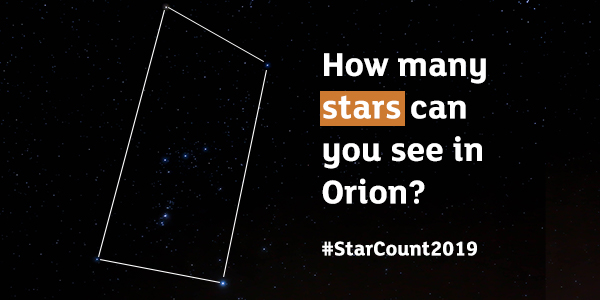In May 2016 the South Downs National Park (including Poynings) became the world’s newest International Dark Sky Reserve (IDSR). We think our star-studded skies overhead are as valuable as our beautiful rolling landscapes and, with properly dark skies in the South East of England under threat, this is a statement that the skies of the South Downs are worth protecting. We celebrate this designation every year at our Dark Skies Festival with two weeks of cosmic fun including star parties, talks and family activities.
In the future the South Downs National Park Authority will use its role as a planning authority to protect the dark skies above the National Park as well as the landscape on the ground. Draft policies for the South Downs National Park’s Local Plan include specific lighting requirements.
Join in the Star count in Poynings, see below.
Star Count 2019
Are you ready? The 2019 Star Count event kicks off next week, and we’d love you to take part!
Getting involved is simple – all you have to do is look up at the night sky and tell us how many stars you can see within the constellation of Orion. You can do this from anywhere in England between Saturday 2 February and Saturday 23 February, but your best opportunity is the week of 2-9 February, when the skies will be darkest.
Your results will help us to create a map showing the best places to enjoy the stars. And it will also support our work to combat light pollution and reclaim our dark skies.
How to take part in Star Count
Try to pick a clear night for your count, with no haze or clouds, then wait until after 7pm so the sky is really dark. Once you’ve found your spot:
- Looking south into the night sky, find the Orion constellation, with its four corners and ‘three-star belt’.
- Take a few moments to let your eyes adjust, then simply count the number of stars you can see within the rectangle made by the four corner stars. You should not count the corners, but you can count the three stars in the middle – the belt. See picture below.

- Make a note of the number of stars seen with the naked eye (not with telescopes or binoculars) and then complete the online survey form: submit your Star Count results. To give you an idea, if you see less than 10 stars, this indicates severe light pollution, and if you can see over 30 stars, you’re looking at a truly dark sky!
- Share your experiences (and any photos) with others on social media using #StarCount2019 @CPRE @BritAstro
And keep a look out for the national results to see how your area compares to the rest of the country!
Submit your Star Count results here
All of this information can also be found on our website at cpre.org.uk/starcount. If you have any queries about Star Count, please contact campaigns@cpre.org.uk.
Best of luck, and don’t forget to enjoy the starry views while you take part!
Thanks for your support.
